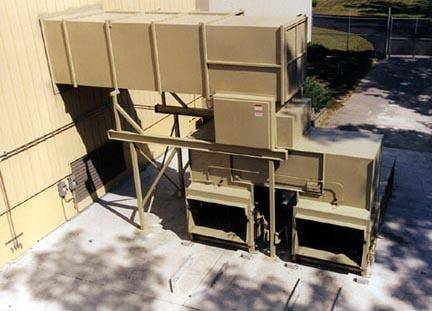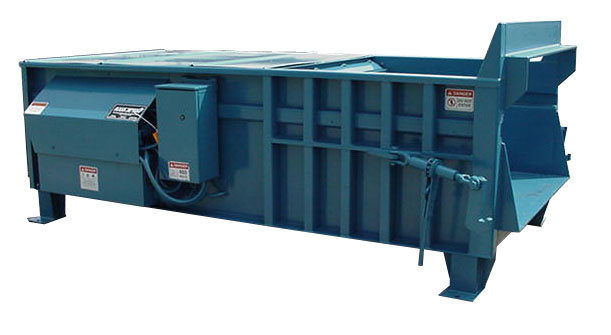Why Industrial waste compaction equipment is vital for eco-friendly operations
Recognizing the Different Usages of Waste Equipment in the Recycling Market
The reusing industry depends greatly on specialized waste devices to enhance processing and recovery. Each tool, from shredders to balers, serves a distinct purpose that enhances total effectiveness. Recognizing these functions is vital for improving sustainability efforts. Commercial garbage compaction equipment. As technology developments, new advancements emerge, assuring to transform standard techniques. This advancement increases important concerns concerning the future of waste management and its influence on environmental conservation. What modifications exist in advance for this essential market?
The Function of Shredders in Material Processing
Shredders play an important function in the recycling market by efficiently processing numerous sorts of waste products. These devices are created to reduce huge items, such as plastics, metals, and organic waste, right into smaller, manageable pieces. This dimension decrease is vital for subsequent recycling processes, as it enables simpler handling and sorting. Along with facilitating recycling, shredders enhance security by reducing the threat of injury connected with dealing with large waste things.
Furthermore, shredders add to ecological sustainability by ensuring that products are refined in a method that optimizes resource healing. They can handle a diverse series of products, making them flexible devices in waste administration facilities. The effective operation of shredders not only streamlines the recycling procedure but likewise boosts the overall performance of waste diversion efforts, promoting a round economic climate. Their relevance in material handling can not be overemphasized, as they function as a foundational step in the direction of sustainable waste monitoring methods.

Exactly How Balers Enhance Effectiveness in Waste Administration
Balers greatly improve effectiveness in waste monitoring by compacting different materials into bundles, which streamlines storage and transport. By compressing recyclables such as cardboard, plastics, and steels, balers significantly lower the quantity of waste. This compression not just maximizes area in recycling facilities yet likewise reduces the variety of journeys required to transport materials, leading to reduced fuel expenses and decreased environmental effect.
In addition, balers add to improved safety in waste administration operations. Small bales are easier to stack and deal with, minimizing the danger of mishaps related to loose materials. The uniform size of bundles permits for more effective filling and dumping processes, streamlining procedures within reusing facilities. Furthermore, balers can enhance the total top quality of recyclables, as properly compacted materials are much less likely to be contaminated. On the whole, balers play a crucial role in maximizing waste administration techniques, promoting sustainability in the recycling sector.
Conveyor Solutions: Enhancing the Recycling Process
Integrating sophisticated equipment like balers substantially boosts waste monitoring procedures, yet the effectiveness of the reusing process is even more boosted via making use of conveyor systems. These systems play a vital role in the seamless transport of products within recycling centers. By promoting the movement of numerous waste kinds, conveyor systems minimize manual handling and minimize the threat of contamination during the reusing process.
Furthermore, conveyor systems can be tailored to fit the unique layouts and functional requirements of recycling centers. Their capacity to operate constantly permits a steady flow of products, look at here now improving efficiency and guaranteeing that sorting and refining devices obtains a constant supply.
Outfitted with attributes like adjustable rates and automated controls, conveyor systems can enhance the flow of products, greatly enhancing general performance (Commercial garbage compaction equipment). These systems are important in contemporary recycling procedures, adding and enhancing procedures to efficient waste monitoring.
Sorting Makers: The Key to Product Recuperation
Arranging equipments are crucial elements in useful reference the reusing market, considerably boosting the performance of product healing. These devices play a crucial function in the splitting up of different recyclable products, permitting a streamlined process that optimizes source extraction. By making use of innovative modern technologies, such as optical sensing units and air classifiers, arranging devices can recognize and classify materials based upon their weight, size, and composition. This ability guarantees that metals, plastics, and paper items are effectively isolated, reducing contamination and enhancing the top quality of recycled outcome.
The operation of arranging devices substantially lowers the dependence on manual labor, which can be both vulnerable and lengthy to mistakes - Commercial garbage compaction equipment. Additionally, the automation offered by these makers increases the overall recycling procedure, resulting in greater throughput and raised functional performance. Consequently, sorting equipments are indispensable in achieving sustainable waste monitoring objectives, making it possible for the recycling industry to successfully recover useful materials while lowering land fill dependency

Technologies in Waste Tools for a Lasting Future
Current innovations in waste tools are driving use this link the recycling sector toward a much more lasting future. Developments such as automated arranging systems, which make use of synthetic intelligence and maker understanding, improve efficiency by precisely recognizing and separating recyclables. This results in greater healing rates and decreased contamination. In addition, developments in compacting innovation permit for extra reliable transportation of products, lessening carbon impacts throughout transportation.
Innovations in shredding equipment improve the processing of complex products, enabling the recycling of products that were when considered non-recyclable. The combination of renewable resource resources, like solar power, in waste handling facilities better adds to sustainability goals. Furthermore, technologies in waste-to-energy technologies and eco-friendly materials are reshaping the landscape of waste monitoring. Collectively, these developments symbolize a transformative shift within the reusing market, advertising not just ecological protection however additionally economic viability for future generations.
Regularly Asked Questions
What Sorts Of Products Can Waste Devices Take Care Of?
The types of products waste tools can take care of include plastics, steels, paper, glass, and natural waste. Each tools type is developed for particular products, enhancing efficiency and effectiveness in arranging and refining numerous waste streams.
How Typically Should Waste Tools Be Maintained?

Exist Safety Interest In Using Waste Tools?
Safety and security problems with utilizing waste equipment consist of possible injuries from mechanical malfunctions, direct exposure to hazardous materials, and inadequate training. Correct upkeep, regular evaluations, and employee education and learning are crucial to reduce these risks successfully in any type of setup.
What Is the Typical Lifespan of Recycling Equipment?
The ordinary life-span of reusing tools normally ranges from 10 to 20 years, relying on aspects such as usage intensity, maintenance practices, and technical improvements, which can considerably affect resilience and effectiveness with time.
How Is Waste Devices Powered in Recycling Facilities?
Waste tools in recycling facilities is usually powered by electrical energy, though some machines may use alternative power sources like gas or diesel. This power makes it possible for effective processing and makeover of materials for recycling objectives.
Shredders play a critical function in the reusing industry by successfully refining numerous types of waste products. They can manage a varied variety of products, making them functional devices in waste management facilities. Balers greatly boost efficiency in waste management by condensing various materials into bundles, which streamlines storage space and transport. The types of products waste equipment can handle consist of plastics, steels, paper, glass, and natural waste. Safety and security concerns with using waste devices include potential injuries from mechanical malfunctions, exposure to dangerous materials, and insufficient training.